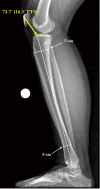The role of anterolateral complex surgery and slope-reducing osteotomies in revision ACL reconstructions: a narrative review
- PMID: 39540063
- PMCID: PMC11558276
- DOI: 10.21037/aoj-24-30
The role of anterolateral complex surgery and slope-reducing osteotomies in revision ACL reconstructions: a narrative review
Abstract
Background and objective: Anterior cruciate ligament reconstruction (ACLR) failures occur for various reasons including residual laxity, untreated concomitant injuries, poor graft quality, and high tibial slope. Various additional procedures can help to decrease revision ACLR failures including anterolateral complex (ALC) procedures and slope-reducing osteotomies for patients with high tibial slopes. This narrative review aims to review the literature on the roles of ALC augmentation procedures and slope-reducing osteotomies in the setting of patients undergoing revision ACLRs.
Methods: A narrative review of relevant literature was performed in July 2024. Studies about anterolateral complex reconstructions and slope-reducing osteotomies in revision ACLRs were included.
Key content and findings: The literature reported that lateral extra-articular tenodesis (LET) and anterolateral ligament reconstructions (ALLR) can be used in revision ACLR cases to significantly reduce clinical knee laxity and the risk of repeated graft failure. There is not currently a strong opinion on which ALC procedure is superior. There are reported slight differences in lateral knee pain and knee stiffness, but both similarly significantly improve clinical and functional outcomes. In revision ACLR cases that also have a high posterior tibial slope (PTS), a slope-reducing tibial osteotomy is warranted. An anterior closing wedge proximal tibial osteotomy (ACW-PTO) significantly reduces anterior tibial translation and graft failure. There is concern about the changes to patellar height, but the literature has found that such changes are either slight or absent by 6 months postoperatively.
Conclusions: The risk of ACLR failure is increased by risk factors like high tibial slope, preoperative knee laxity, and prior ACLR rupture. Anterolateral complex procedures and slope-reducing osteotomies may be used to address these specific concerns and reduce the risk of graft rupture. For revision ACLR cases with lower PTS, augmentation with a LET or an ALLR to reduce the risk of graft failure and improve rotational stability may be warranted. In the setting of a revision ACLR in patients with a high PTS of ≥12°, a concomitant ACW-PTO and ALC procedure should be considered to decrease the risk of an ACLR graft failure.
Keywords: Anterolateral complex; anterolateral ligament reconstruction (ALLR); lateral extra-articular tenodesis (LET); revision anterior cruciate ligament reconstruction (revision ACLR); slope-reducing osteotomy.
2024 AME Publishing Company. All rights reserved.
Conflict of interest statement
Conflicts of Interest: All authors have completed the ICMJE uniform disclosure form (available at https://aoj.amegroups.com/article/view/10.21037/aoj-24-30/coif). R.F.L. serves as an unpaid editorial board member of Annals of Joint from September 2024 to December 2026. R.F.L. has research grants from Ossur, Smith & Nephew, AANA, and AOSSM; collects royalties from Ossur, Smith & Nephew, and Elsevier; collects consulting fees from Smith & Nephew and Ossur; has patents planned, issued, or pending from Smith & Nephew and Ossur; is on the editorial boards of AJSM, JEO, KSSTIA, JKS, IJSPT and OTSM. The other authors have no conflicts of interest to declare.
Figures





References
-
- Firth AD, Bryant DM, Litchfield R, et al. Predictors of Graft Failure in Young Active Patients Undergoing Hamstring Autograft Anterior Cruciate Ligament Reconstruction With or Without a Lateral Extra-articular Tenodesis: The Stability Experience. Am J Sports Med 2022;50:384-95. 10.1177/03635465211061150 - DOI - PMC - PubMed
-
- Getgood AMJ, Bryant DM, Litchfield R, et al. Lateral Extra-articular Tenodesis Reduces Failure of Hamstring Tendon Autograft Anterior Cruciate Ligament Reconstruction: 2-Year Outcomes From the STABILITY Study Randomized Clinical Trial. Am J Sports Med 2020;48:285-97. 10.1177/0363546519896333 - DOI - PubMed
Publication types
LinkOut - more resources
Full Text Sources
